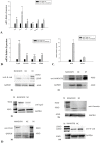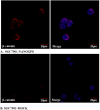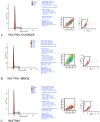NANOGP8 is the key regulator of stemness, EMT, Wnt pathway, chemoresistance, and other malignant phenotypes in gastric cancer cells
- PMID: 29689047
- PMCID: PMC5915267
- DOI: 10.1371/journal.pone.0192436
NANOGP8 is the key regulator of stemness, EMT, Wnt pathway, chemoresistance, and other malignant phenotypes in gastric cancer cells
Abstract
Background: Accumulating evidence demonstrated that NANOG1, the key transcription factor for embryonic stem cells, is associated with human cancers. NANOGP8, one of the pseudogenes in NANOG gene family, contains an intact open reading frame and also said to be expressed in cancer tissues. Therefore, a systematic study is greatly needed to address the following questions: among NANOG1 and NANOGP8, which gene is the main contributor for NANOG expression in cancer cells and which one is the key regulator responsible for stemness, epithelial-mesenchymal transition (EMT), metastasis, chemoresistance and other malignant phenotypes. Here we try to explore these issues with gastric adenocarcinoma cell lines in vitro using variety of molecular and cellular techniques.
Methods: Special primers were designed to distinguish PCR products from NANOG1 and NANOGP8. Sphere-forming cells were cultured with serum-free and selective medium. A stable cell line was established with infection of lentivirus containing NANOGP8. qPCR was performed to measure NANOGP8 expression and its association with stemness, EMT and CSC markers in adherent cells and sphere-forming cells. Western blot analysis was deployed to confirm results of the transcript analysis. Experiments of cell proliferation, migration, invasion, clonogenic assay, sphere cell growth assays, cell cycle analysis, β-catenin accumulation and translocation in nucleus, and drug resistance were conducted to measure the impact of NANOGP8 on malignant statuses of gastric cancer cells. Immunofluorescence staining was used to analyze cell subpopulations with different markers.
Results: NANOGP8 is mainly responsible for NANOG expression in sphere-forming (stem cell-like) cells derived from gastric cancer cell lines regardless their differentiation status. Ectopic expression of NANOGP8 significantly up-regulates stemness transcription factors, EMT inducers, and cancer stem cell markers (CSC) including Lgr5. NANOGP8 also promotes expression of the signature genes vimentin and N-caderin for mesenchymal cells and down-regulates the signature gene E-caderin for epithelial cells whereby confer the cells with mesenchymal cell phenotype. In NANOGP8 over-expressed adherent and sphere-forming cells, Lgr5+ cells are significantly increased. Ectopic expression of NANOGP8 endows gastric cells with enhanced proliferation, migration, invasion, sphere-forming and clonogenic capacity, and chemoresistance. NANOGP8 expression also enhances β-catenin accumulation in nucleus and strengthens Wnt signal transduction.
Conclusion: NANOGP8 is the main regulator of gastric cancer stem cells. It is closely associated with EMT, stemness, and CSC marker as well as Wnt signal pathway. NANOGP8 is correlated with cell proliferation, migration, invasion, clonogenic capacity, β-catenin accumulation in nucleus, and chemoresistance in gastric cancer. NANOGP8 is a promising molecular target for clinical intervention of gastric cancer.
Conflict of interest statement
Figures








Similar articles
-
LGR5 Is a Gastric Cancer Stem Cell Marker Associated with Stemness and the EMT Signature Genes NANOG, NANOGP8, PRRX1, TWIST1, and BMI1.PLoS One. 2016 Dec 29;11(12):e0168904. doi: 10.1371/journal.pone.0168904. eCollection 2016. PLoS One. 2016. PMID: 28033430 Free PMC article.
-
Inhibition of Wnt/β-catenin pathway reverses multi-drug resistance and EMT in Oct4+/Nanog+ NSCLC cells.Biomed Pharmacother. 2020 Jul;127:110225. doi: 10.1016/j.biopha.2020.110225. Epub 2020 May 16. Biomed Pharmacother. 2020. PMID: 32428834
-
Frizzled7 Promotes Epithelial-to-mesenchymal Transition and Stemness Via Activating Canonical Wnt/β-catenin Pathway in Gastric Cancer.Int J Biol Sci. 2018 Feb 12;14(3):280-293. doi: 10.7150/ijbs.23756. eCollection 2018. Int J Biol Sci. 2018. PMID: 29559846 Free PMC article.
-
Wnt/β-catenin pathway as a link between therapy resistance-driven epithelial-mesenchymal transition and stemness in colorectal cancer.Cell Biol Int. 2025 Feb;49(2):154-160. doi: 10.1002/cbin.12270. Epub 2024 Dec 20. Cell Biol Int. 2025. PMID: 39707719 Review.
-
Oncogenic Metabolism Acts as a Prerequisite Step for Induction of Cancer Metastasis and Cancer Stem Cell Phenotype.Oxid Med Cell Longev. 2018 Dec 23;2018:1027453. doi: 10.1155/2018/1027453. eCollection 2018. Oxid Med Cell Longev. 2018. PMID: 30671168 Free PMC article. Review.
Cited by
-
Pseudogene KRT17P3 drives cisplatin resistance of human NSCLC cells by modulating miR-497-5p/mTOR.Cancer Sci. 2021 Jan;112(1):275-286. doi: 10.1111/cas.14733. Epub 2020 Nov 28. Cancer Sci. 2021. PMID: 33179318 Free PMC article.
-
AI-Powered Insights into Drug Resistance in Gastric Cancer: A Path Toward Precision Therapy.Iran J Pharm Res. 2025 May 25;24(1):e159954. doi: 10.5812/ijpr-159954. eCollection 2025 Jan-Dec. Iran J Pharm Res. 2025. PMID: 40708930 Free PMC article. Review.
-
MicroRNA-93-5p promotes epithelial-mesenchymal transition in gastric cancer by repressing tumor suppressor AHNAK expression.Cancer Cell Int. 2020 Mar 12;20:76. doi: 10.1186/s12935-019-1092-7. eCollection 2020. Cancer Cell Int. 2020. Retraction in: Cancer Cell Int. 2024 Apr 30;24(1):154. doi: 10.1186/s12935-024-03340-2. PMID: 32190000 Free PMC article. Retracted.
-
Epithelial-Mesenchymal Transition: Role in Cancer Progression and the Perspectives of Antitumor Treatment.Acta Naturae. 2020 Jul-Sep;12(3):4-23. doi: 10.32607/actanaturae.11010. Acta Naturae. 2020. PMID: 33173593 Free PMC article.
-
Adapting and Surviving: Intra and Extra-Cellular Remodeling in Drug-Resistant Gastric Cancer Cells.Int J Mol Sci. 2019 Jul 31;20(15):3736. doi: 10.3390/ijms20153736. Int J Mol Sci. 2019. PMID: 31370155 Free PMC article. Review.
References
-
- Khazaei S, Rezaeian S, Soheylizad M, Khazaei S, Biderafsh A. Global Incidence and Mortality Rates of Stomach Cancer and the Human Development Index: an Ecological Study. Asian Pac J Cancer Prev. 2016; 17(4):1701–1704. - PubMed
-
- Jemal A, Bray F, Center MM, Ferlay J, Ward E, Forman D. Global cancer statistics. CA Cancer J Clin. 2011; 61(2):69–90. doi: 10.3322/caac.20107 - DOI - PubMed
-
- Bonnet D, Dick JE. Human acute myeloid leukemia is organized as a hierarchy that originates from a primitive hematopoietic cell. Nature Medicine. 1997; 3(7):730–737. - PubMed
-
- Takahashi K, Yamanaka S. Induction of pluripotent stem cells from mouse embryonic and adult fibroblast cultures by defined factors. Cell. 2006; 126(4):663–676. doi: 10.1016/j.cell.2006.07.024 - DOI - PubMed
Publication types
MeSH terms
Substances
LinkOut - more resources
Full Text Sources
Other Literature Sources
Medical
Research Materials
Miscellaneous

